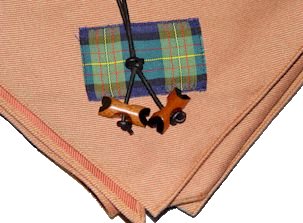The Scout section of Scouts Canada is for boys and girls ages 11 to 14 (optional to 16). The program offers two main types of badges, Challenge Badges and Activity badges. The Challenge badges are round whereas the Activity badges are square or diamond-shaped. The Activity badges have two levels indicated by the border colour and shape: red and square-shaped for Voyageur and green and diamond-shaped for Pathfinder. Activity badges are required to achieve 3 out of the 4 awards, the Voyageur Scout Award, the Pathfinder Scout Award and the Chief Scout's Award, the fourth being the World Scout Environment Award.
Obtaining all 4 of the red border Activity badges, 4 challenge badges and the Spring/Fall Year-Round Camper award entitles one to the Voyager Scout Award. Obtaining all 4 of the green border Activity badges, 6 more challenge badges and the Summer and Winter Year-Round Camper awards entitles one to the Pathfinder Scout Award. Obtaining the Pathfinder Scout Award is one step to the Chief Scout's Award.
To obtain the Chief Scout's Award, the highest rank in Scouts Canada at the Scout level, one must earn the Pathfinder Scout Award, the Standard First Aid Award (St. John Ambulance or Red Cross), at least one Challenge badge from each category, the World Scout Environment Award, do a presentation about the World Scouting Movement and make a challenging program for each of the 4 categories (Citizenship, Leadership, Outdoor Skills and Personal Development). The Citizenship program must require 30 hours of leadership to others. After these 6 steps, you are eligible for the Chief Scout's Award.
This award is designed to demonstrate a Scout's concern for, and active stewardship of, the environment. The badge shows Antarctica - the only collectively managed continent in the world and one of the most at risk from climate change - at its center. The other land-forms create a world image inside a green border. In order to earn it, the Scout must complete the Climate Change and Emergency Preparedness Challenge badges, do at least 2 of the following badges (Fish and Wildlife, Soil and Water Management, Forestry), make a presentation about how their community is addressing climate change, research a local environment issue and do an 8-hour environmental project with their troop.
Challenge badges are worn on the right sleeve. There are 51 of them. The requirements are typically done alone, instead of with groups.

A Scout is a child, usually 10–18 years of age, participating in the worldwide Scouting movement. Because of the large age and development span, many Scouting associations have split this age group into a junior and a senior section. Scouts are organized into troops averaging 20–30 Scouts under the guidance of one or more Scout Leaders. Troops subdivide into patrols of about 6–8 Scouts and engage in outdoor and special interest activities. Troops may affiliate with local, national, and international organizations. Some national Scouting associations have special interest programs such as Air Scouts, Sea Scouts, outdoor high adventure, Scouting bands, and rider Scouts.
Advancement and recognition in the Boy Scouts of America is a tradition dating from the inception of the Scouting movement. A fundamental purpose of advancement is the self-confidence a young man or woman acquires from his participation in Scouting. Advancement is one of the methods used in the "Aims of Scouting"– character development, citizenship training and personal fitness.

Wood Badge is a Scouting leadership programme and the related award for adult leaders in the programmes of Scout associations throughout the world. Wood Badge courses aim to make Scouters better leaders by teaching advanced leadership skills, and by creating a bond and commitment to the Scout movement. Courses generally have a combined classroom and practical outdoors-based phase followed by a Wood Badge ticket, also known as the project phase. By "working the ticket", participants put their newly gained experience into practice to attain ticket goals aiding the Scouting movement. The first Wood Badge training was organized by Francis "Skipper" Gidney and lectured at by Robert Baden-Powell and others at Gilwell Park in September 1919. Wood Badge training has since spread across the world with international variations.

A camporee is a local or regional gathering of Scouting units for a period of camping and common activities. Similar to a camporee, a jamboree occurs less often and draws units from the entire nation or world. It should not be confused with the Australian term "jamborette".

Venturing is one of the core programs of the Boy Scouts of America, serving young men and women. Members must be at least 14 years old, or 13 years old and have completed eighth grade, through age 21.

A Queen's Scout is a Scout who has attained the Queen's Scout Award. The Queen's Scout Award is the highest youth award achievable in the Scouting movement in the Commonwealth realms, including the United Kingdom, Canada, Australia, and New Zealand, where Scouts operate under the patronage of Queen Elizabeth II. Whether the award recipient is a Queen's or King's Scout depends on who is the current Monarch of the Commonwealth realms.
Scouts South Africa is the World Organization of the Scout Movement (WOSM) recognised Scout association in South Africa. Scouting began in the United Kingdom in 1907 through the efforts of Robert Baden-Powell and rapidly spread to South Africa, with the first Scout troops appearing in 1908. South Africa has contributed many traditions and symbols to World Scouting.

The American Heritage Girls (AHG) is a Christian-based Scouting-like organization for Americans. The organization has more than 52,000 members (2020) with troops or individuals ("trailblazers") in all 50 states of the United States and for American expatriates in fifteen other countries.

Scouts BSA is the flagship membership level of the Boy Scouts of America (BSA) for boys and girls between the ages of 11 and 17. It provides youth training in character, citizenship, and mental and personal fitness. Scouts are expected to develop personal religious values, learn the principles of American heritage and government, and acquire skills to become successful adults.

Scouts, often referred to as the Scout section to differentiate itself from the wider movement and its parent organisation, is a section of Scouting run by The Scout Association for ten and a half to fourteen year old young people. The section follows on from Cub Scouts and precedes Explorer Scouts. Since 1991, the section has been coeducational and today the Scout section accepts young people from all backgrounds, faiths and genders.
The Queen's Venturer Award is the highest Scouting proficiency award for youth members in Scouts Canada that can be regularly awarded, as the Amory Adventure Award is only awarded to one Venturer Company each year. When the Scout program was divided into Scouts and Venturers the highest award, the Queen's Scout Award, was renamed to reflect its application to the Venturer section. The award is presented to Venturers who have acquired competence and skills that will be of considerable use to themselves, their company, and their community. These Venturers will have also been recognized by the company, the advisor, and Scouts Canada as being worthy of receiving the Award.

The Chief Scout's Award is the highest award which can be achieved at the Scout level in Scouts Canada. It was inaugurated in 1973 by then Governor General of Canada Roland Michener. The award was created to provide recognition for Scouts when the Scout program was divided into the Scout and Venturer sections. The former Queen's/Kings's Scout award was renamed as the Queen's Venturer Award, and is the highest award that can be achieved in the Scouting youth program in Canada. Speaking to the prestige of the award, at least one known Chief Scout has gone on to win a Nobel Prize, 4 have become Members of Parliament and at least 1 has been a Premier. Others have become titans of industry, technology, academia, finance and media.

Scouts in Scouting Ireland are aged between 11 and a half to 16 years of age. Each group has a Court of Honour/Patrol Leader's Council which under the guidance of an adult Scouter designs and implements activities. Scouts is the section where activities begin to really challenge the youth member and impart responsibility and self-reliance in accordance with the Scout method and the educational philosophy of Baden-Powell. The association also currently has Sea Scout and Air Scout programmes. The highest award is the Chief Scout Award

The Chief Scout Award is the highest youth programme award in each of the Programme Sections in Scouting Ireland. It is designed to tie-in with the Gaisce Award/Duke of Edinburgh's Award, and the Chief Scout Award for Scouts, Venture Scouts, and Rover Scouts are awarded jointly with the Bronze, Silver and Gold awards respectively. Requirements for the award are a number of Adventure Skills, Special Interest Badges, an Expedition, and camp with an inter-cultural aspect. The progress of the award is led by the participant, with the help of the Scouter.

The advancement program for Scouts participating in the Scouts BSA is symbolized by the earning of seven ranks. The advancement program is often considered to be divided into two phases. The first phase from joining to First Class is designed to teach the scout Scoutcraft skills, how to participate in a group and to learn self-reliance. The Scout badge is awarded when the Scout demonstrates a rudimentary knowledge of the Scouting ideals and program. Tenderfoot, Second Class, and First Class have progressively harder requirements in the areas of Scoutcraft, physical fitness, citizenship, personal growth and Scout Spirit.
The rank insignia system of the Indonesian Scouting movement Gerakan Pramuka is by and large militarized in traditions and outfit.
Youth organizations in the United States are of many different types. The largest is the government run 4-H program, followed by the federally chartered but private Scouting movement groups: the Boy Scouts of America (BSA) and the Girl Scouts of the USA (GSUSA). Another somewhat smaller but co-ed Scouting derived group is Camp Fire. Other youth groups are religious youth ministries such as the evangelical Christian Awana, Seventh-day Adventist Pathfinders, and Assemblies of God Royal Rangers.

The Venturing Summit is the highest rank for youth in the Venturing program of the Boy Scouts of America. It requires Venturers to earn the Pathfinder Rank, participate in adventures, and demonstrate leadership, service and personal growth.
Advancement and recognition in the Scout Association of Hong Kong is a tradition dating from the inception of the Scouting movement. A fundamental purpose of advancement is the self-confidence a young man or woman acquires from his participation in Scouting. Advancement is one of the methods used in the "Aims of Scouting"– character development, citizenship training and personal fitness.
The personal progression system for youth members of Scouting Ireland has been designed and refactored since the merger of earlier organisations.